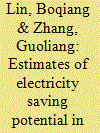| Srl | Item |
| 1 |
ID:
124437


|
|
|
|
|
| Publication |
2013.
|
| Summary/Abstract |
The paper analyzes the electricity saving potential of nonferrous metals industry in China. The cointegration method is applied to estimate electricity intensity of Chinese nonferrous metals industry, in an effort to predict future electricity saving potential. The results show that there is a long-run equilibrium between electricity intensity and factors such as R&D intensity, industrial electricity price, enterprise scale, and labor productivity. By means of scenario analysis, we evaluate different possible measures that might be adopted to narrow down the electricity efficiency gap between nonferrous metals industry in China and that of Japan. The results indicate that more active electricity conservation policies are needed in order to reduce the electricity intensity of Chinese nonferrous metals industry. We also find that the electricity efficiency gap could be significantly narrowed by 2020 if proper electricity conservation policy is adopted. Finally, based on the results of the scenario analysis, future policy priorities are suggested.
|
|
|
|
|
|
|
|
|
|
|
|
|
|
|
|
| 2 |
ID:
112314


|
|
|
|
|
| Publication |
2012.
|
| Summary/Abstract |
The purpose of this study is to investigate the future electricity saving potential of China's chemical industry. Applying cointegration, we find that there is a long-run equilibrium relationship between electricity intensity and technology, labor, electricity prices and industry structure. The result shows that more active electricity saving policies are objectively required to be implemented in order to reduce the electricity intensity in China's chemical industry as well as to shrink future electricity saving potential. For this purpose, we have adopted a scenario analysis method to predict the electricity intensity and the electricity saving amount under two different scenarios. It is found that energy conservation policy provides a continuous impetus for reducing the electricity saving potential. In terms of electricity intensity of the chemical industry, China's intensity is approaching the level in Japan, with the gap narrowing significantly by the year 2020. Finally, based on the elasticities obtained in the long-term equilibrium equation, the paper suggests a range of future policy priorities and directions.
|
|
|
|
|
|
|
|
|
|
|
|
|
|
|
|